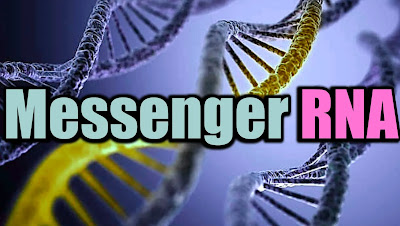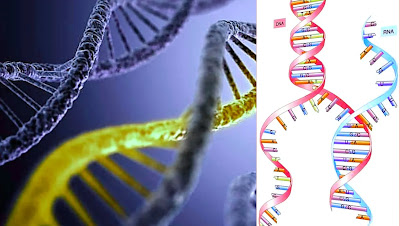Messenger RNA (mRNA) are transfer RNAs (tRNA) that carry information from DNA to ribosome. They are complementary to mRNA. The mRNAs are the blueprint for the synthesis of proteins, while tRNA act as translators of genetic information. You can think of mRNA as a copy of DNA that is sent to the ribosome to be translated into amino acids according to the genetic code. Once they arrive at the ribosome, they attach themselves to an appropriate tRNA molecule carrying an amino acid that corresponds with the nucleotide sequence in the mRNA.Blog List:
1. Messenger RNA Definition
2. Messenger RNA Role
3. Messenger RNA Function
4. What Do Messenger RNAs Do?
{tocify} $title={Table of Contents}
1. Messenger RNA Definition
Messenger RNA, or mRNA, is the polymer that carries the genetic information from the DNA in the nucleus to the ribosome in the cytoplasm, where it is translated into the amino acids that form the proteins.
Messenger RNAs have a highly conserved structure. They are designated A, C, G, AUG, AGC, ATG, AGA, AGA2, AGA3 and AGA4, and are transcribed into novel combinations of amino acids in the absence of the 3′-untranslated region (UTR). Messenger RNAs are transcribed into mRNAs for both genes and non-gene genes. Human genes are composed of a set of ~831 genes accounting for 90% of total genes in the human genome. Each gene has a designated messenger RNA, which carries the genetic information from coding sequence, to translating RNA, to the ribosome. The remaining 10g is non-coding genetic information. The ribosome is composed of one mRNA, or protein using an analogy from the double helix model of DNA.
Messenger RNA specific to a gene is called a non-coding region (NR), and the amino acids that are packaged into a non-coding region are referred to as non-protein-coding sequences (NP). Messenger RNAs, however, can sequence information to comprise coding sequence plus an external sequence (UTR). It is important to note that the amino acid information in a messenger RNA, or non-coding region, does not change in a change-to-coding sequence.
Messenger RNAs do not contain a tell-tale “ticking clock” that is seen in the presence of certain transcription factors, which code the amino acids, translate them into a mRNA, and control the ribosome activity.
Messenger RNA and Retriever regulated target (or "reference") mRNAs regulate transcription of target genes using signals from upstream DNA that are activated by messenger RNAs. Operators of the transcription factor are often designated AUG, AUG2, ATG, AGA, AGA3, AGA4 and ACTB. Transcription factors are labeled by amino acids and their synthetic abbreviations. An example of an amino acid is leucine which is linked to the amino acid tryptophan.
2. Messenger RNA Role
Messenger RNA (mRNA) is a type of RNA that transfers genetic information from DNA to the places in the cell where proteins are made. During protein synthesis, the mRNA uncoils and separates to expose the genetic information in its nucleotide sequence, which allows ribosomes to attach to it. Messenger RNA composition varies between species but typically consists of 20–50 amino acids that correspond to those in the protein-coding regions of the genes.
2. Third messenger RNAs (mRNA) read by ribosomes function like messenger RNAs, but they are copies of the information already written in DNA. Third messenger RNA pairs with messenger RNA to form long-term storage forms known as proteins.
3. Muscle-type glycogen is a type of pre-exercise fuel used by muscle to help build and maintain muscles during endurance training. In the glycogen within the muscle fibers, stem cells divide into daughter cells which become muscle-muscle fibers. During this division process, a new enzyme is created that is involved in breaking down the cellular wall that surrounded each stem cell. The enzyme creates a new form of glycogen, known as an intermediate complex. A swollen mucus membrane coats the small intestine wall, protecting it from digestion and speeding its movement through the digestive pipeline. Once the enzymes of the intermediate complex are completed digestion, water mixes with the cellular liquid, forming an insoluble complex that passes slowly through the digestive tract and throughout the body. It is this final component of the muscle-muscle complex that is digested and digested into its constituent amino acids, which are used by the muscle cells during exercise.
4. Carbohydrate usage before and during exercise determines the overall availability of usable energy for fat-burning and muscle-building. To perform an effective workout, carbohydrates ideally must be used. To get carbs to work faster and improve performance, several factors must be considered:
The individual executing the exercise must use the correct technique to avoid injury. For example, doing full-body exercises with poor technique called faulting posture can limit your utilization of carbohydrates.
3. Messenger RNA Function
Messenger RNA is a type of RNA that is created in the nucleus of a eukaryotic cell, and it is then exported into the cytoplasm of the cell. The cytoplasm of the cell is where the ribosomes are, and this is where the messenger RNA is needed to direct the production of proteins. Messenger RNAs have a lot in common with the sequences of the small proteins in which messenger RNA is bound, which map to specific amino acids. So, when you think of messenger RNAs, think of amino acids. Sequence similarity means those amino acids are consistently found in proteins and in messenger RNAs. On the other hand, the amino acids in messenger RNAs and small proteins do not always occur in the same order, which is known as the human variation.
When you're thinking of proteins, think of individual amino acids, and not the monoclonal antibodies that are produced to target those specific amino acids.
2. Many conditions (e.g., sickle cell anemia, vacuous gut syndrome, Down Syndrome, and more) are linked to variations in the genetic material that is inherited from generations of mothers and fathers. The variations create unique proteins in the pregnant mother (maternal-specific genes) and unique proteins in the developing fetal tissues (paternal-specific genes). The crawling of messenger RNAs is necessary to ensure each gene is expressed as an individual protein needed by the fetal tissue.
In order to properly guide the production of proteins, eukaryotic cells make proteins that are also specific to each individual individual protein. This process happens during each cell division. Messenger RNAs help guide this process by allowing the eukaryotic cells to copy themselves, rather than receiving instructions from a template.
As you can probably surmise, reading this section made you work up a little or two of devilishly smart and witty T-shirts you could put on. This created the same effect we expected.
3. Many of the 1,000 to 5,000 genes (out of 17,000+) that make up the human genome have a template to introduce or modify from.
4. What Do Messenger RNAs Do?
Messenger RNAs are one of the many ways cells communicate, and they are used to send messages from one part of the cell to another. These messages are used to control the function of the cell, and are important in the development of the embryo. There are three main types of messenger RNAs, and they are categorized by their length.2. Messenger RNA type B (mRNAB) comprises the majority of mRNAs. They are divided into long and short variants.
3. Messenger RNA type C (mRNAC) is the least abundant of the three, found in a small, but significant proportion of cells in the body.
MEMENT1 is the acronym for “microRNA-1”. RAW264 is an mRNA coding sequence for a protein associated with inflammation.
The mRNAs (small molecules) act as instructions for the cell’s proteins. As the mRNA travels through messenger RNA to ribosome, it creates a link with a microRNA called miRNA.
miRNA plays one of two roles. It either regulates the translation of a given mRNA, or it is native to the mRNA and directly interacts with the ribosome to carry the mRNA along. miRNA can be derived from any other DNA molecule, introduces foreign chemical compounds with the help of its attached messenger RNA, or acts as a template for building other functional molecules. miRNA carriers contain the chemical residue GTP (guanine-phosphorylhydronucleotide), and it is found on ribosomes and other small subunits of the ribosome (mRNA granules).
The frequency of specific mRNA types can be assessed using the UCSC genome browser. As illustrated below, the variation among human populations is much more extensive than was previously thought.
Messenger RNA typing is not common among the different human ethnicities. A recent study states that “Copy number variants (CNVs) in messenger RNA are more common within Jewish than within non-Jewish populations and are even more common among Ashkenazi Jewish individuals.”
The viral or bacterial DNA damage and repair pathway activated by miRNA is poorly understood. It plays a crucial role in cancer development and in the proliferation and survival of cancer cells.
We’ve already established messenger RNA function within the cell.
Conclusions: mRNAs are the middlemen between DNA and proteins, but they are not there to make proteins all by themselves. They need tRNAs to get the job done, and without them the process stops short of completion. Their role is very important, however, because they are what give life to every cell of every living thing on Earth.
The most interesting thing about mRNAs is that they are the middlemen. Let me explain. DNA is like the blueprint for everything in your body, and it can make proteins all by itself. But it doesn't. It needs these middlemen (mRNAs) to get the job done, and without them the process stops short of completion.At each step along the way, different mRNAs do their part. In the case of DNA, messenger RNAs repair or modify the base pair sequences that determine which amino acids to use as building blocks to build proteins. messenger RNA Cas9 encodes for a protein-specific element, and since only one of these sites is important for building a protein, if we can find and silence these two messenger RNAs, we can stop those pesky building proteins from happening. If you can't silence them, you’re stuck with mess in your proteins.
messenger RNAs are organized into two categories, non-homologous and homologous. Homologous is the over-lapping of messenger RNAs. Non-chaperoned, non-double-stranded RNA (also called non-homologous) is like the double-stranded version of messenger RNAs that doesn’t do a double duty. Instead, it makes a particle that can be packaged into a DNA-protein complex. This packaged object can take on the characteristics of the protein it’s wrapped up in.
NOTE: DNA does NOT have a ribosome or a protein-making complex, as it needs to stay silent all the time.
Here’s another example. DNA is made of two complementary strands, A and C, that are continually spinning back and forth to make new copies of themselves. With each rotation of one A or C, alternating letters (adenine and guanine, for example) are switched on and off, signaling different amino acids. Again, there are two types of these RNAs: A and C.
Non-homologous RNAs are adjacent to A/C, called plasmids. Both carry a protein-specific element called a exon. By switching these RNAs off, proteins can't be made, and the plasmids are powerless.
Homologous RNAs (homologous to A and C) are like the double stranded version of A and C, with A and C still attached.









0 Comments